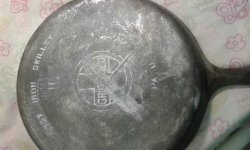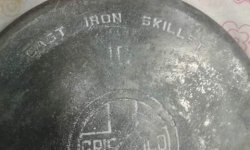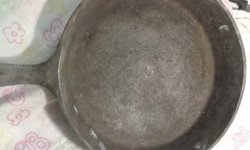In the mid to late 19th century, advancement in casting technology brought about the technique of side gating. It would move the gate away from the bottom to a place where its remnant would no longer be physically obtrusive and any vestige of it could be rendered inconspicuous. But this would mean you could no longer simply take a thing shaped like a skillet (aka a pattern), pack it in a box of sand, remove it leaving a cavity in its shape, drill a hole or slot to the cavity down through the sand, and then pour molten iron into it. Patterns now had to be more elaborate affairs with runners and multiple gates and risers in order to make the iron fill the cavity completely and evenly, from the bottom up, against gravity.
Companies like Wagner and Griswold, who began hollow ware manufacture around this time, perhaps encouraged to do so by the quality of product the improved method would allow, used side gating from the outset. Bottom gating continued to be used, however, by smaller foundries without the capability, but they quickly fell by the wayside. Bottom gating also persisted on large pieces like cauldrons where side gating was impractical or was deemed unnecessary. And, it continued to be seen used by individuals or small foundries making copies of others' pieces.
In the case of Griswold, there are only a few instances where a bottom gated piece might be thought to be genuine, but they are confined to a small number of early gem or breadstick pans and a few early tea kettles.
There are a few places you'll see people claim a bottom gated piece marked Griswold is genuine. One is on eBay, and we don't have to say anything more than that.
Another is in the sometimes lengthy, rambling, and often incoherent comments section of a facebook post. Many guesses and assumptions, posted in them by those with only a casual level of interest, often come to be taken as fact by readers coming in later.
And to be fair, many years ago even an author of the BB and RB (before he wrote the books) thought that an Erie skillet with a bottom gate mark he found was earlier than all the others he had, and for a time placed it in the sequence of revisions collectors call "series". His books, however, are probably better for having taken a moment to clear up that brief misconception.
Griswold did also make a full line of cast aluminum ware in addition to cast iron, but no other metals.
 :confused
:confused


